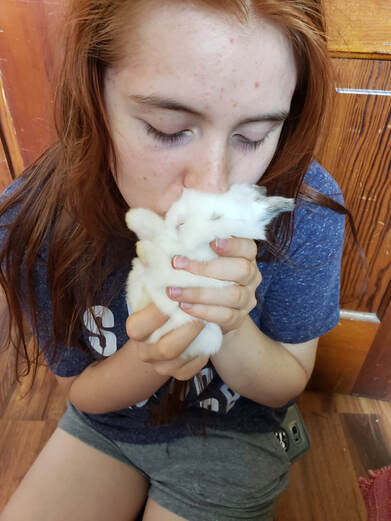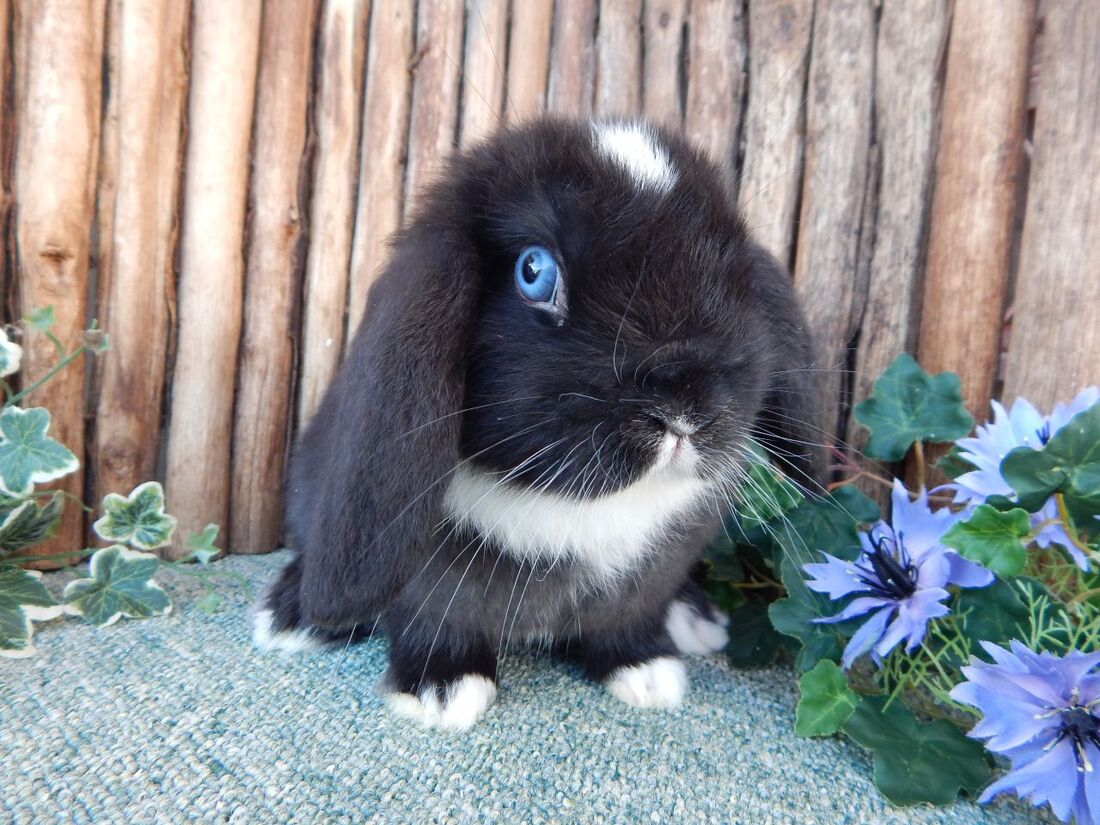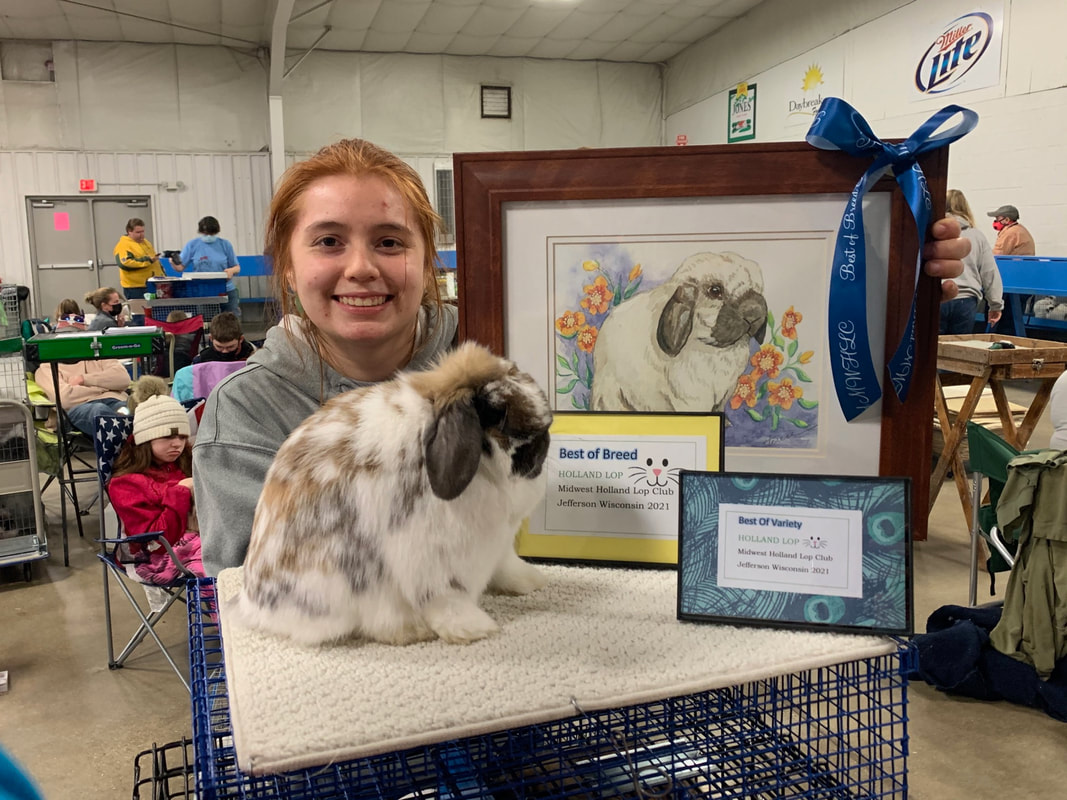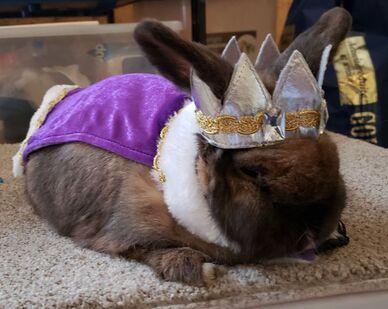
Faith with Stubby as baby
Colors Holland Lop rabbits are available in many colors and patterns. Part of the charm of the Holland Lop is the variety of colors available in the breed. Numerous colors are available across several groups. The following is a list of the recognized colors that are eligible for show: Self Group: Black, Blue, Chocolate, Lilac, Ruby-Eyed White, Blue-Eyed White Agouti Group: Chestnut, Chocolate, Chinchilla, Chocolate Chinchilla, Lynx, Opal, Squirrel Broken: Any color with white Pointed White: Black, Blue, Chocolate, Lilac Shaded: Sable Point, Seal, Tortoise (black, blue, chocolate, or lilac), Siamese Sable, Smoke Pearl Tan: Otter (black, blue, chocolate, lilac) Ticked: Gold-Tipped or Silver-Tipped Steels in Black, Chocolate, Blue, or Lilac Wide Band: Cream, Fawn, Frosty, Orange, Red, Tricolors Un-Showable Colors There are many colors that are not recognized for showing by the ARBA Unfortunately we see many people selling them to new owners who don't know any better. While some of these exotic or rare colors are fun, they can never be shown if that is what your goal is. If you just want a nice pet, then that is just perfect, but due to breeders wanting certain colors, like harlequins for instance, it's safe to assume that somewhere in that rabbits history a breeder used a real Harlequin, which is an actual breed of commercial rabbit that comes in Japanese and Magpie colors. Another issue we see is new enthusiasts want rare colors in show quality, which are extremely hard to find, expensive and rarely have the show quality types. We see youth come to their 1st show with a BEW, or another of the rare colors and their rabbits place last, you can see the disapoitment on the child's face. The torte colors have been established for a long time due to lack of selection in other colors based on types. Many people breed less than optimal types just for the colors they want, that just sets their rabbits up for a lack of show quality, and good types for many generations. Some of the un-showable colors in Holland Lops are: Harlequin Magpie Blue Point Torte Otter Smoke Pearl Martin Vienna Marked Charlie (Any broken with less than 10% color Markings, absence of at least 1/2 a butterfly marking around the nose, eye circles & as fully colored ears as possible)) WE (White-Eared) And many more... * The picture above is Faith with a Charlie named Stubby. There are legitimate breeders that use unshowable colors for breeding programs, an example is: Tri-Color has to use harlequins, due to the fact that a tri-color rabbit is essentially a broken harlequin. In our experience those that are serious about those programs don't usually sell too many, as it's a long and hard process. Here are a few websites to help you see what is what in the world of color: https://hickoryridgehollands.com/holland-lop-color-guide https://www.ohiohollandlops.com/bunny-color-chart.html https://www.gbfarm.org/rabbit/holland-colors-shaded.shtml http://www.bunnylops.com/holland-lop-colors.html And the correct way to breed for colors: https://cedarpointrabbitry.com/wp-content/uploads/2018/02/Holland-Lop-Color-Chart-Draft-1.pdf AS Always; please double check ABRA's Standard of Perfection to see if a color is showable, and what is acceptable in those color groups. Harlequin Colored Holland Lop on the Left-Unshowable; the only breeding program they can be used in is for Tri-Colored, using them for any other purpose creates unrecognized colors. This particular rabbit has a decent type, and is most likely being used for a tri-color project.
On the Right you have a VM marked Blue-Eyed Holland Lop-unshowable and only used for BEW programs which are extremely difficult. This rabbit is very badly typed, thin boned, long broody ears, slipped crown, etc. Clealy pet quality only... THESE ARE NOT OUR RABBIT-ONLY EXAPMLES OF UNSHOWABLE COLORS |
Stars Hollow Rabbitry began in 2018 as a way for Faith to build relationships, social skills, and confidence, all while doing something she loved, being with animals. She joined the Ozaukee County Rabbit project (4-H), and then began going to ARBA shows, and the rest is still history in the making! Faith started with one Holland Lop doe, who we have nick named "Queen B", she is a treasured pet and lives in Faith's bedroom, she is very much part of the family. Faith's 2nd rabbit was a rescue, Bobby a New Zealand & Lionhead mix that we got from the Ozaukee County Humane Society when he was only 6-8 weeks old, he could fit in the palm of our hand! He was neutered, and micro-chipped, litter box trained and could free roam with our 2 rescue dogs. Bobby was probably around #8-#9 and so well behaved, we forgot he was out of his cage, as he would just go sleep in one of the dog beds, he never bothered anything unless it was another buck, if it was the does or dogs he would just play with them. Right now we maintain 25-35 adult Holland Lops and a few retired pets. It's a lot of work, time, money and sacrifice, but very rewarding. As with most enthusiasts, we started out with pets and became educated about shows, the differences in show quality rabbits verses pet, raising, breeding and caring for them. We are always in the process of continuous education, understanding the variety breeds, history of how breeds evolved, breed standards, shows, medical issues, genetic issues, breeding problems & solutions, breed specialty clubs, proper nutrition, the difference in feed types, the list goes on and on. It is never boring, and there is ALWAYS something to learn, no one could ever know everything! Faith & Stars Hollow's Gr.Champion Nita (Klicko's Blue Moon & Swade's Claire) TOP LOP-YOUTH #6 January March 2022 Bagger RBA Show 3/13/2021 Show A-1st place junior broken doe Show B-1st place junior broken doe/BOSG/BOS Midwest Holland Lop Specialty Show 3/14/2021 Show A-1st placejunior broken doe/BOB Show B-1st place junior broken doe/BOV Best in Show for show B Lakeland Show 5/23/2021 Show A-1st place senior broken doe Show B-1st place senior broken doe/BOB Fox Valley Show 6/12/2021 Show A-1st place senior broken doe/BOV Show B-1st place senior broken doe/BOV/BOB Between the Lakes Show 7/11/2021 Show A-1st place senior broken doe/BOB/BOV Show B-1st place senior broken doe/BOSV Fox Valley Show 9/25/2021 Show B-1st place senior broken doe/BOV Tri-County/Jefferson Show 10/9/2021 Show B-1st place senior broken doe/BOV The Photo Below is Compliments of Diana Strauss Rehman This Doe is PROOF that show rabbits don't always come from show rabbits & that GOOD brood stock, from solid foundations of reputable breeders CAN be the producers of your show quality rabbits! The key is that you have to put the work in yourself and not expect to just buy random rabbits and put them on the show tables and win. Breed carefully, be selective, do your homework, and put the time and energy into working with them, handling them, observing them, figure out what crosses work and don't, and put effort into cultivating your own lines...this breed is not for the lazy, or easily disuaded! Also, NEVER forget to be thankful to the breeders and mentors that help you, you'll achieve a lot more, and go a lot futher by respecting, listening, and working with those that KNOW what they are doing!!! If your lucky and find sucess, pay it forward and help others, that is how the hobby grows in a positive way.
What is a color project? The 1st thing you need to know is that the black torte/broken black torte variety is the most common color in Holland Lops. About 95% of Holland Lops at the show tables are black torts, with the occasional blue tort, broken varieties, or black. As black tort is the most common color, more breeders are working on tortes more than any other color. That means that the standard of tortes is higher than other colors because most people are working with tortes. The remaining 5% or so are all the other forty-something recognized colors in the Holland Lop breed. These colors are rare, and they are called project colors or "colored Hollands". Because there are less people working on them, the standard of these colored Hollands is typically lower. So when there is a colored Holland on the show table, they are less likely to win or place well. The General rule is: no matter what color you work with, the quickest and most effective way of improving type is by breeding to a high quality torte. Most people lack understanding of genetics, and find it confusing or frustrating, but the unfortunate truth is that if you want to work with project colors, you've got to understand genetics. The reason for this is that by understanding genetics, you will be able to work with carriers, avoid color crosses you might regret later, and make smarter breeding choices in general. By not understanding genetics, you might also make decisions that negatively impact others who purchase rabbits out of your line in the future. There is tons of great information on basic genetics available on the internet, and if you ask around, you might even be able to find a rabbit breeder who can explain it to you. If you would prefer not to learn genetics, just stick to tortes. |




